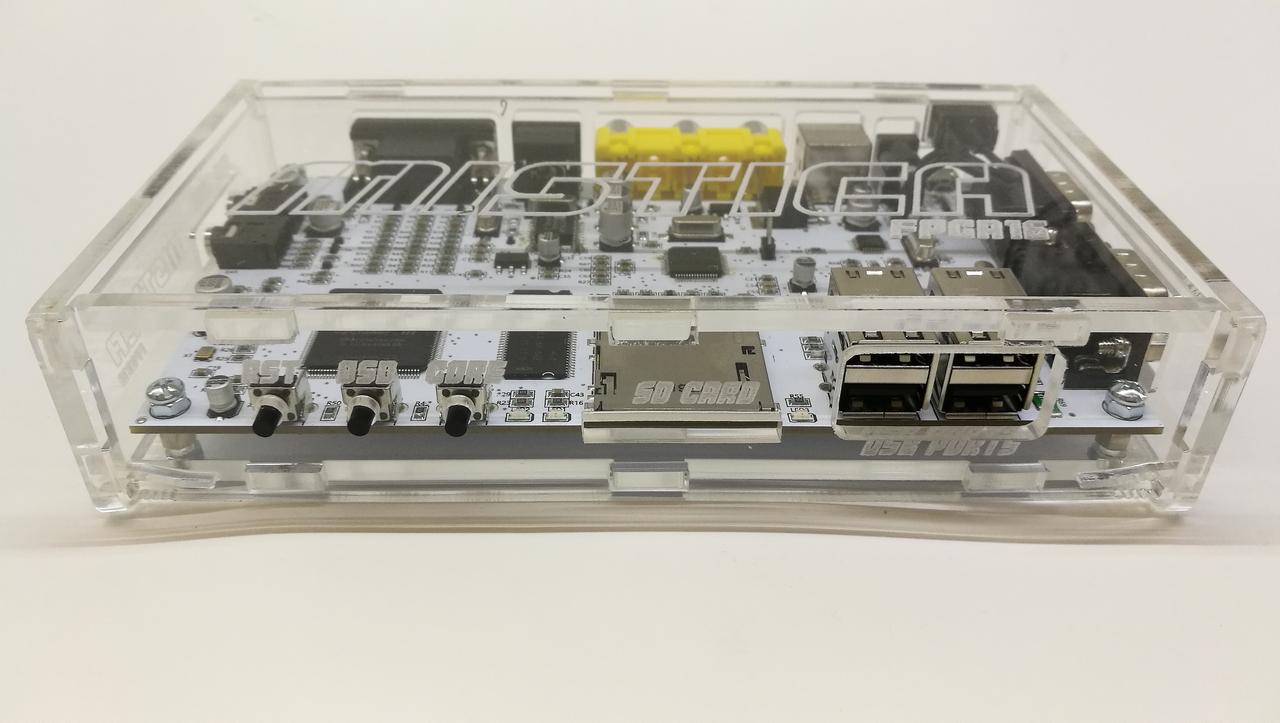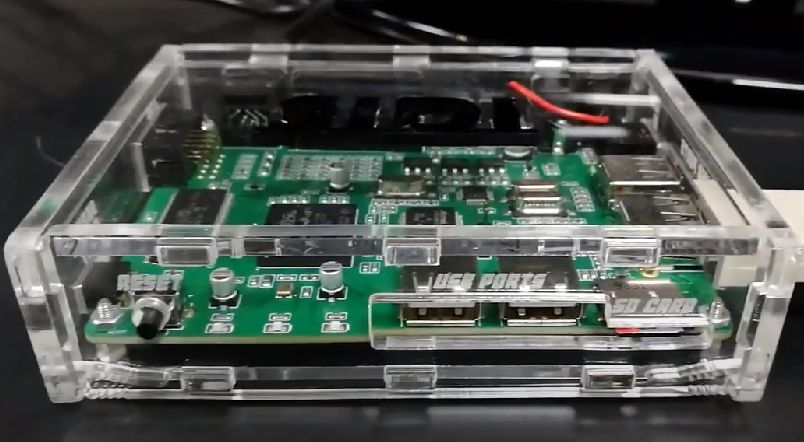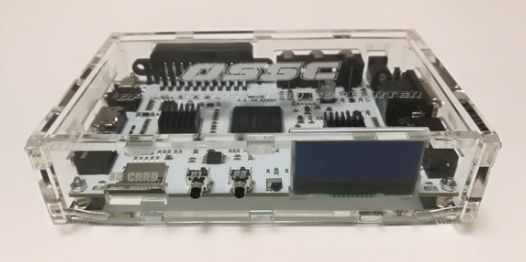Suivez-nous sur X

|
|
|
0,
A,
B,
C,
D,
E,
F,
G,
H,
I,
J,
K,
L,
M,
N,
O,
P,
Q,
R,
S,
T,
U,
V,
W,
X,
Y,
Z,
ALL
|
|
0,
A,
B,
C,
D,
E,
F,
G,
H,
I,
J,
K,
L,
M,
N,
O,
P,
Q,
R,
S,
T,
U,
V,
W,
X,
Y,
Z
|
|
0,
A,
B,
C,
D,
E,
F,
G,
H,
I,
J,
K,
L,
M,
N,
O,
P,
Q,
R,
S,
T,
U,
V,
W,
X,
Y,
Z
|
|
A propos d'Obligement

|
|
David Brunet

|
|
|
|
Interview with Manuel Fernández Higueras
(Interview conducted by David Brunet - September 2020)
|
|
Manuel Fernández Higueras is a spanish hardware designer. He has already designed numerous devices such as
the Mistica FPGA16, the OSSC and more recently the SiDi, an FPGA Amiga clone. He has given us an interview that
you can read below.
 Hello Manuel.
Can you introduce yourself? Hello Manuel.
Can you introduce yourself?
My name is Manuel, I live near Barcelona, I am 46 years old, I am dedicated to the design and assembly of
electronic circuits on my own. I work in my own house, in the garage, I have everything I need to produce
electronic boards in an industrial way. Solder wave machine, printer screen, pick and place, oven, laser cut, etc.
 When and how
did you discover the Amiga? When and how
did you discover the Amiga?
I discovered the Amiga in 1989, thanks to a friend Jordi Morales invited me to his house to see his computer
and he showed me games like Xenon 2, Kick Off, Prince Of Persia and some more that I don't remember.
I had a ZX Spectrum and was impressed with the technological leap between 8 and 16-bit systems. From that day
on my dream was to have a Commodore Amiga.
 What are/was your
favourite activities on Amiga? What are/was your
favourite activities on Amiga?
My favorite activity was playing, then programming, graphics, sound. I also liked creating comics with Deluxe
Paint recreating my friends and the adventures that we had had on some crazy weekend. I speak in the
past tense, I have not actively used Amiga since 1997, now I only use it as something nostalgic.
 Did you
still use an Amiga today? Did you
still use an Amiga today?
No, since I left it in 1997 and bought my first PC I have only used it in emulators to play a game from time to
time my favorites have always been Kick Off 2, Mega Lo Mania, K240 and Superfrog. Every so often I like to
load the emulator and remember them.
In the last 3 years I have changed the emulator for FPGAs since it gives me a much closer feeling to the real equipment.
 Your Mistica
FPGA16 computer is available since 2017. Could you tell us the story behind it? Your Mistica
FPGA16 computer is available since 2017. Could you tell us the story behind it?
The MiST fascinated me, it seemed to me an incredible system at that time the best. It had a small drawback
and it was the price, I wanted to make my own version with a more popular price, I added what the users
demanded at that time, composite video output and audio input, and so the Mistica was born, a clone of MiST
at a more affordable price and with some improvements.
The name was given by my friend Ricardo from Retroshop, he was inspired by a comic character from the x-men.
He even wanted the circuits to be blue like the character.
 Mistica FPGA16
Mistica FPGA16
 What are the
specifications of the Mistica FPGA16? In which areas is it better or worse than a real Amiga (like A1200)? What are the
specifications of the Mistica FPGA16? In which areas is it better or worse than a real Amiga (like A1200)?
Mistica has a Cyclone III EP3C25 FPGA with 32 MB SDRAM memory and an Atmel AT91SAM7S256D microcontroller.
The Minimig core in Mistica gives 6.17 MIPS in SysInfo, comparable to an A1200/030 40Mhz in performance,
although the processor implementation is a very accelerated 68020.
 SiDi is another
of your FPGA computer. Could you also tell us the story behind it? What did motivate you to create the SiDi,
knowing that there was already several other systems like the Mistica, ZXUNo, MiST, ST-Mini, MiSTer... SiDi is another
of your FPGA computer. Could you also tell us the story behind it? What did motivate you to create the SiDi,
knowing that there was already several other systems like the Mistica, ZXUNo, MiST, ST-Mini, MiSTer...
At the end of last year 2019, SiDi appeared, it also belongs to the MiST universe, it shares the same ARM
processor although this time it has a Cyclone IV EP4CE22 FPGA. It's a FPGA slightly smaller than EP3C25 but
with a much lower price. This makes it possible to do a much smaller circuit also eliminating the DB9 ports
and leaving only the USB ones.
The challenge was to make an FPGA with a core catalog the same as MiST and with a price not exceeding 100 euros.
I am very happy with the result, it is a very robust and reliable FPGA, all the MiST cores are ported and an
edition with a metal housing will be released shortly.
 SiDi
SiDi
The performance of the cores is the same as in MiST, the core of Minimig gives exactly the same result in SysInfo
as MiST or Mistica. It is a great product if you want to enter the world of FPGAs without spending
more than 100 euros. I honestly think that right now it is the most competitive FPGA in relation to price and
what it offers.
I must thank Jotego for his direct support to SiDi of its arcade cores such as CPS1. It is incredible to
see his work in SiDi arcades like Final Fight or Street Fighter II.
 SiDi is really
cheap (99 euros) but it lacks DB9 ports and HDMI output. Did you plan to add them in a possible new version? SiDi is really
cheap (99 euros) but it lacks DB9 ports and HDMI output. Did you plan to add them in a possible new version?
It is an option that I have been studying. Make a high-end MiST universe board, including a FPGA of
more capacity E55 to be able to run cores such as NeoGeo or MegaCD, with HDMI, Wi-Fi, 8bit video DAC and
digital sound. But it is something that is currently stopped by the problem that board designers have
encountered, which is the MiSTer, a board with impressive specifications at a price impossible to match
because it is an Intel/Altera board subsidized by an educational project, as well as impressive work by
Sorgerlig. Right now in high-end it is impossible to compete with MiSTer.
Although, I can perhaps make improvements to SiDi such as DB9 and HDMI without influencing the price too much.
 What is the
main difference between the SiDi cores and the MiST cores? What is the
main difference between the SiDi cores and the MiST cores?
None, it is resynthesized for the new FPGA model and the performance is the same. SNES, Genesis, Amiga, Atari STe
all work exactly the same on a SiDi as on a MiST.
 Do we always
have to wait your work to get the MiST core ported on the SiDi? Or is a simple copy/paste of the MiST cores works? Do we always
have to wait your work to get the MiST core ported on the SiDi? Or is a simple copy/paste of the MiST cores works?
It is a very simple operation that is done in 15 minutes, I have an automatic script that does it, you take
the source for MiST, you execute the script and it synthesizes the SiDi version. Quartus can take
between 5 and 15 minutes in this operation.
 Did you plan to
contact Cloanto/Amiga Corporation to add official Kickstart ROMs? Did you plan to
contact Cloanto/Amiga Corporation to add official Kickstart ROMs?
No, I do not sell the content of the SD card, I manufacture and sell the FPGA board. Then everyone is responsible
for adding the content.
 Are your FPGA
computers selling well? Are your FPGA
computers selling well?
For me, it sells very well. I am a single person with an electronic workshop in his garage with everything
necessary to manufacture: solder wave machine, screen printer, pick and place, oven, laser cut machine.
I only do it with the help of my wife, we manufacture everything we sell, we have no employees.
Among all FPGA models, we manufacture and sell about 400-500 FPGA equipment per year. Our main market being
Spain (25%) and the remaining 75% European countries such as France, Italy, Germany or Portugal.
 Could you
introduce your other products like the video converter OSSC? Could you
introduce your other products like the video converter OSSC?
Yes, I have a custom OSSC (Open Source Scan Converter), it is 100% the same as the original. The only change is the form
factor and I redesigned the circuit so that the mount is 1-sided for easier manufacturing. It has a similar price to the official
OSSC manufactured in China, only that in my case it is manufactured by me in the European Union.
 OSSC from Manuferhi
OSSC from Manuferhi
 Did you design
your products on your own or are you helped by others people? Did you design
your products on your own or are you helped by others people?
The design and manufacture is my exclusive task, then I have external help in adapting some cores, I have
good friends like Rampa and Fernando Mosquera who have helped me in adapting some cores.
 What do you
think of other FPGA machines like the MiST, MiSTer, UnAmiga or Minimig? What do you
think of other FPGA machines like the MiST, MiSTer, UnAmiga or Minimig?
To this day, all FPGAs have been overshadowed by MiSTer, it is the undisputed king of FPGAs. Minimig was a
pioneer in Amiga just like Zemmix or OCM in MSX, but they have become obsolete because they include
FPGAs that have been obsolete. MiST reigned during a few years until the arrival of MiSTer and UnAmiga.
It is a custom Chinese PCB that I think is no longer manufactured. From that board, I made a "Sidewinder"
version that was 100% compatible, but the absence of an ARM, essential for many cores, made it evolve to the SiDi.
 We can buy your
hardware on your website.
Do you plan to propose also your hardware to Amiga resellers? We can buy your
hardware on your website.
Do you plan to propose also your hardware to Amiga resellers?
It is an option that I contemplate, but at the moment, I only sell in my store because I have problems keeping
stock. Luckily, everything that I manufacture very well is sold and it does not give me to send material
to other stores, even so I have had contacts and I'm not ruling it out in the near future.
 Beside your
hardware works, did you have developed some software on Amiga? If yes, which ones? Beside your
hardware works, did you have developed some software on Amiga? If yes, which ones?
I did some things in AMOS Basic many years ago, but nothing professional. It was very simple games that
helped me learn programming. But I have nothing published, my level is very amateur.
 What are your
next projects? What are your
next projects?
Right now, I'm with a clone of the ZX Spectrum Next, which will go on sale later this year. I already have the
prototypes working and I only have a few adjustments in the firmware for the board to go on sale. It is a clone
100% equal to the ZX Spectrum Next, with the approval of the creators of the Next: 2MB memory, LX16 FPGA, Wi-Fi,
RTC, accelerator RPI connector, HDMI and edge connector.
 What do you
think about the next generation Amiga operating systems? (AROS, AmigaOS 4, MorphOS) What do you
think about the next generation Amiga operating systems? (AROS, AmigaOS 4, MorphOS)
To be honest, I have not tried these systems. My experience with the Amiga ended in 1997 waiting for the long-awaited
PowerPC accelerators. At that time, I had an Amiga 1200/060 before putting it in the warehouse and
buying a PC. Once it was saved, I did not use it again up to 15 years later to see if it was still working, and yes.
But I have never used the new operating systems. For me the Amiga was finished in 1997.
 What do you think
about the current Amiga situation? What do you think
about the current Amiga situation?
In 1997, I had friends who told me "forget the Amiga and go to the PC, don't be stubborn."
I was the ultimate advocate for the Amiga and its possible rebirth. In those days, I thought I was
a survivor of the Amiga until I let him go. I will always carry in my heart the Commodore Amiga. It has been by
far the most important computer in my life, something that cannot be explained. Even when I look at its
casing I get excited. For me, it's the best computer in its time.
But that is over, more than 20 years have passed and now computing does not look much like that of the 1990's
and it cannot be compared. Although, since I have been manufacturing FPGAs, I have been amazed at the number
of Amiga users that still exist. But personally, I have no interest in seeing a new Amiga computer appear.
 Do you have a
message for the Amiga community? Do you have a
message for the Amiga community?
We were lucky to experience the birth of microcomputers, and meet the Amiga and enjoy it. We are privileged, it
is the message that we have to spread to our children.
|



 Hello Manuel.
Can you introduce yourself?
Hello Manuel.
Can you introduce yourself? When and how
did you discover the Amiga?
When and how
did you discover the Amiga? What are/was your
favourite activities on Amiga?
What are/was your
favourite activities on Amiga? Did you
still use an Amiga today?
Did you
still use an Amiga today? Your Mistica
FPGA16 computer is available since 2017. Could you tell us the story behind it?
Your Mistica
FPGA16 computer is available since 2017. Could you tell us the story behind it?
 What are the
specifications of the Mistica FPGA16? In which areas is it better or worse than a real Amiga (like A1200)?
What are the
specifications of the Mistica FPGA16? In which areas is it better or worse than a real Amiga (like A1200)? SiDi is another
of your FPGA computer. Could you also tell us the story behind it? What did motivate you to create the SiDi,
knowing that there was already several other systems like the Mistica, ZXUNo, MiST, ST-Mini, MiSTer...
SiDi is another
of your FPGA computer. Could you also tell us the story behind it? What did motivate you to create the SiDi,
knowing that there was already several other systems like the Mistica, ZXUNo, MiST, ST-Mini, MiSTer...
 SiDi is really
cheap (99 euros) but it lacks DB9 ports and HDMI output. Did you plan to add them in a possible new version?
SiDi is really
cheap (99 euros) but it lacks DB9 ports and HDMI output. Did you plan to add them in a possible new version? What is the
main difference between the SiDi cores and the MiST cores?
What is the
main difference between the SiDi cores and the MiST cores? Do we always
have to wait your work to get the MiST core ported on the SiDi? Or is a simple copy/paste of the MiST cores works?
Do we always
have to wait your work to get the MiST core ported on the SiDi? Or is a simple copy/paste of the MiST cores works? Did you plan to
contact Cloanto/Amiga Corporation to add official Kickstart ROMs?
Did you plan to
contact Cloanto/Amiga Corporation to add official Kickstart ROMs? Are your FPGA
computers selling well?
Are your FPGA
computers selling well? Could you
introduce your other products like the video converter OSSC?
Could you
introduce your other products like the video converter OSSC?
 Did you design
your products on your own or are you helped by others people?
Did you design
your products on your own or are you helped by others people? What do you
think of other FPGA machines like the MiST, MiSTer, UnAmiga or Minimig?
What do you
think of other FPGA machines like the MiST, MiSTer, UnAmiga or Minimig? We can buy your
hardware on your website.
Do you plan to propose also your hardware to Amiga resellers?
We can buy your
hardware on your website.
Do you plan to propose also your hardware to Amiga resellers? Beside your
hardware works, did you have developed some software on Amiga? If yes, which ones?
Beside your
hardware works, did you have developed some software on Amiga? If yes, which ones? What are your
next projects?
What are your
next projects? What do you
think about the next generation Amiga operating systems? (AROS, AmigaOS 4, MorphOS)
What do you
think about the next generation Amiga operating systems? (AROS, AmigaOS 4, MorphOS) What do you think
about the current Amiga situation?
What do you think
about the current Amiga situation? Do you have a
message for the Amiga community?
Do you have a
message for the Amiga community?











